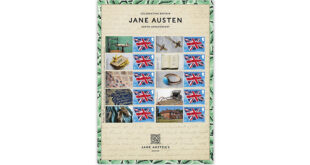By David Hartwig
On Aug. 1, the United States Postal Service will recognize the 50th anniversary of the tabletop game Dungeons & Dragons with an issue of 10 forever stamps.
“By inviting participants to imagine themselves as wizards, warriors and other adventurers in exciting and treacherous fantasy worlds,” the Postal Service said, “the game opened doors to whole new universes of creativity for generations of players.”
The designs of the 10 nondenominated (73¢) commemorative stamps highlight characters, creatures and encounters familiar to players of the fantasy role-playing game.
Art director Greg Breeding designed the stamps using existing art from Dungeons & Dragons publisher Wizards of the Coast.
The stamps are available in panes of 20 containing two stamps with each design. The selvage of the pane depicts a group fighting a dragon, a 20-sided die and a detail from a typical Dungeons & Dragons map.
The U.S. Postal Service will host first-day activities at two locations in Indianapolis Aug. 1 for the Dungeons & Dragons stamps.
The stamps will be unveiled at 10 a.m. Aug. 1 as part of Gen Con Indy, the largest and longest-running gaming convention in North America, held Aug. 1-4 at the Lucas Oil Stadium, 500 S. Capitol Ave., in Indianapolis.
Greg Breeding will be available for autographs following the unveiling, and retail sales and cancellations of the stamps will be available all four days of the convention.
Entry into Gen Con Indy requires the purchase of a pass. A single-day pass for Thursday, Aug. 1, costs $74 and can be purchased online.
For those who do not wish to purchase a pass to Gen Con Indy, the USPS will sell the stamps and offer cancellations Aug. 1 at the Indianapolis main post office at 125 W. South St., across the street from Lucas Oil Stadium.
Dungeons & Dragons was first published in 1974 by Tactical Studies Rules Inc. after Gary Gygax and Dave Arneson collaborated to design the game. Since 1997, the game has been published by Hasbro subsidiary Wizards of the Coast.
The game is played by a group of players. One player acts as the dungeon master, who is responsible for creating the game’s narrative, controlling nonplayer characters and adjudicating the rules.
The other players create and control their own characters, each with unique abilities and attributes, to explore, complete quests and overcome various challenges.
Players can choose characters from a variety of races, classes, backgrounds and alignments. Races include fantasy staples, such as humans, elves, dwarfs and orcs.
Classes, such as fighter, wizard, rogue and cleric, define a character’s abilities and role within the party. Players also select a background that provides additional skills, equipment and role-playing opportunities.
The outcomes of the players’ actions are often determined by rolling polyhedral dice, the most common being the 20-sided die. The rolled results are then modified by the characters’ attributes, skills and other factors.
The attributes of strength, dexterity, constitution, intelligence, wisdom and charisma further define characters and influence a wide range of in-game activities, from combat effectiveness to social interactions.
Gameplay of Dungeons & Dragons is divided into three main activities: exploration, social interaction and combat.
Players explore the game’s world, discovering hidden locations, solving puzzles, and gathering resources. The dungeon master describes the environment and events, and players decide how to respond and proceed.
Players interact with other characters using their skills and attributes to negotiate, persuade and gather information. This aspect of the game emphasizes role-playing and character development.
When conflicts arise, the game shifts to a more tactical mode. Players and the dungeon master take turns to act, with characters moving on a grid and performing actions such as attacking, casting spells or using items.
Combat outcomes are determined by dice rolls, modified by characters’ abilities and circumstances.
Dungeons & Dragons involves a combination of storytelling, strategy and chance. The blend of chance and choice allows for a dynamic and unpredictable game experience.
Since its initial release in 1974, Dungeons & Dragons has undergone several revisions and editions, each refining and expanding the game’s rules and content. The fifth and most recent edition of the game was published in 2014.
The new stamps mark 50 years of Dungeons & Dragons’ profound influence on popular culture. The game has inspired countless books, video games, movies and TV shows in its 50 years of fostering a sense of community among its players.
This comes despite the significant cultural controversy during the 1980s.
The controversy largely stemmed from misunderstandings and misconceptions about the game. Critics argued that Dungeons & Dragons’ themes of magic, fantasy violence and occult elements could lead to antisocial behavior, mental health issues, and even satanic practices.
A few highly publicized incidents in which players were involved in criminal activities or mental health crises exacerbated these fears. Notably, a case of a …
To continue reading this story, subscribe to Linn’s Stamp News.
Connect with Linn’s Stamp News:
Sign up for our newsletter
Like us on Facebook
Follow us on Twitter

